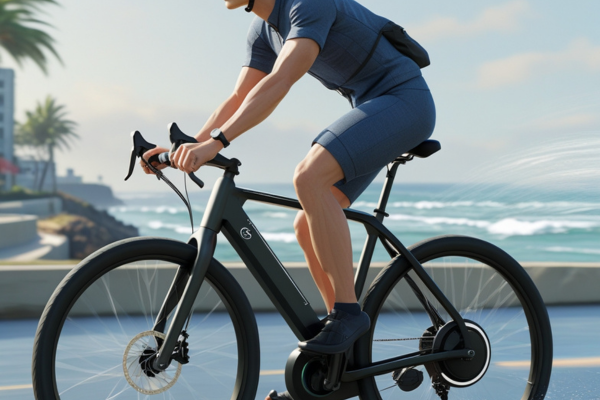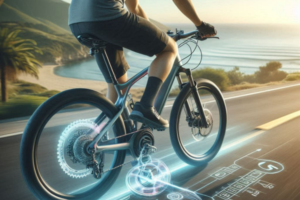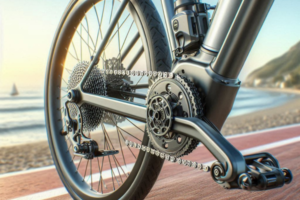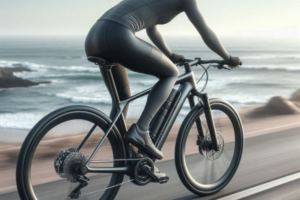🚴♀️ Aerodynamics: The Key to Effortless Speed
When it comes to cycling, especially with electric bicycles, many riders focus on increasing power output or upgrading components to achieve higher speeds. However, one of the most effective and often overlooked methods to enhance speed without additional power is optimizing your aerodynamic position. By reducing air resistance, you can ride faster and more efficiently, conserving energy and extending battery life.
🌬️ Understanding Aerodynamic Drag
Aerodynamic drag is the resistance experienced by an object moving through air. In cycling, this resistance increases exponentially with speed, meaning that as you go faster, the air pushes back harder. Studies have shown that at speeds around 30 km/h (18.6 mph), aerodynamic drag accounts for approximately 70-90% of the total resistance a cyclist faces on flat terrain. Therefore, minimizing this drag is crucial for improving speed and efficiency.
🧍♂️ The Role of Body Position
Your body position on the bike significantly influences aerodynamic drag. A more streamlined posture reduces the frontal area exposed to the wind, decreasing resistance. For instance, lowering your torso closer to the handlebars and tucking in your elbows can lead to noticeable speed gains. Adopting such positions doesn’t require additional power; instead, it allows you to maintain or even increase speed with the same or less effort.
📈 Benefits for Electric Bicycle Riders
For electric bicycle enthusiasts, optimizing aerodynamics offers dual advantages. Firstly, it enhances speed without draining the battery faster, allowing for longer rides. Secondly, it complements the motor’s assistance, making climbs and headwinds more manageable. By focusing on body positioning, e-bike riders can maximize their rides’ efficiency and enjoyment.
🔍 Real-World Implications
Consider this: a cyclist maintaining a speed of 25 km/h (15.5 mph) in an upright position might require a certain amount of power. By simply adjusting to a more aerodynamic posture, the same cyclist could achieve the same speed with less effort or go faster with the same effort. This principle applies to all cyclists, regardless of their bike type or fitness level.
🛠️ Practical Tips for Improving Aerodynamics
- Lower Your Torso: Aim to keep your back flat and parallel to the ground.
- Tuck in Your Elbows: Bringing your elbows closer to your body reduces frontal area.
- Use Aero Accessories: Consider adding aero bars or wearing form-fitting clothing.
- Maintain a Steady Head Position: Keeping your head low and steady minimizes turbulence.
Implementing these adjustments can lead to significant improvements in speed and efficiency, all without increasing your power output.
💡 Insight: “Aerodynamics isn’t just for professional racers; it’s a tool every cyclist can harness to ride smarter and faster.”
📐 Aerodynamic Positions for Every Type of Rider
You don’t have to be a professional racer to benefit from a more aerodynamic posture. In fact, electric bicycle riders—whether commuting, touring, or riding for fitness—can significantly reduce drag with subtle posture improvements. The key is to find a position that balances comfort, control, and air resistance. Let’s explore three riding styles and how each can adapt aerodynamic principles. 🧭
🔰 1. The Commuter Position
Commuters often ride upright for visibility and comfort in traffic. While this position increases drag, there are small adjustments that can reduce resistance without compromising safety:
- 🧍♂️ Lower your shoulders slightly and lean forward when safe.
- 🤲 Keep your elbows tucked closer to your torso instead of flaring out.
- 🎒 Minimize gear on your back and consider panniers instead of backpacks to reduce your frontal profile.
🚴♀️ 2. The Performance Position
For riders seeking speed and efficiency—whether on a road e-bike or a hybrid—this posture delivers a significant aerodynamic boost:
- 🔻 Lower your torso so it’s more parallel to the ground.
- 🤏 Keep your forearms horizontal and elbows pointed slightly downward.
- 👕 Use snug-fitting apparel to reduce air resistance caused by flapping fabric.
🏞️ 3. The Touring or Casual Position
Touring riders prioritize endurance and comfort. Even here, some smart tweaks can help reduce wind drag over long distances:
- 🌬️ Slightly lean forward while gripping the upper part of the handlebars.
- 🛍️ Pack gear low and close to the bike frame to streamline the bike’s profile.
- 🎯 Avoid bulky outer layers; opt for layered, smooth-surfaced clothing.
Regardless of your riding category, small changes in posture and gear arrangement can yield big aerodynamic results. Just a 5–10% reduction in frontal area can significantly boost speed or reduce battery strain.
📊 Comparison Table: Rider Position vs. Aerodynamic Efficiency
| Rider Type | Default Posture | Potential Aero Gains | Comfort Level |
|---|---|---|---|
| Commuter | Upright, open arms | Low to Medium | High |
| Performance | Torso lowered, elbows tucked | High | Moderate |
| Touring | Slight forward lean | Medium | High |
💡 Pro Tip: Start by holding each new posture for just a few minutes at a time. Gradual adaptation helps your body adjust without strain.
💡 Inspiration: Your posture is a quiet conversation with the wind. The more you listen, the more it lets you pass.
⚠️ Common Mistakes When Trying to Ride Aerodynamically
Adopting a more aerodynamic riding position can improve your electric bicycle’s performance dramatically—but only if done correctly. Many riders unknowingly make adjustments that compromise comfort, handling, or even safety, all in the name of speed. In this section, we’ll explore the most frequent mistakes and how to correct them so you can ride smarter, not just faster. 🧠💨
🛑 Top Errors Riders Make
- 📏 Over-tucking the body: Going too low too quickly can cause neck strain and affect balance, especially for beginner riders.
- 🧍♀️ Incorrect saddle height or angle: A seat that’s too high or tilted forward forces awkward positions that defeat aerodynamic goals.
- 🎒 Wearing loose or bulky clothing: Even a slightly flapping jacket can increase drag significantly.
- 👐 Arms too wide or tense: Riding with flared elbows increases frontal area and adds turbulence instead of reducing it.
- ⚡ Ignoring core engagement: Weak core support causes riders to collapse their upper body, compromising posture and control.
📊 Table: Mistake vs. Impact
| Mistake | Immediate Effect | Long-Term Consequence |
|---|---|---|
| Excessive torso lowering | Neck and back discomfort | Reduced control and posture fatigue |
| Saddle misalignment | Uneven weight distribution | Knee strain, hip pain |
| Flapping clothing | Increased wind resistance | Loss of aerodynamic benefit |
📋 Checklist: Smart Aerodynamic Adjustment
- ☐ Adjust saddle height gradually and test in short rides
- ☐ Use form-fitting or aerodynamic gear
- ☐ Keep your elbows tucked but relaxed
- ☐ Maintain neutral wrist and neck position
- ☐ Strengthen your core to stabilize your position
🧠 Visual Analogy: Don’t Ride Like a Closed Book
Imagine slamming a hardcover book shut—everything gets compressed and stiff. That’s what happens when you over-tuck your body in search of aerodynamics. The goal is not to fold, but to flow. A good aerodynamic posture is more like a streamlined paper airplane—light, balanced, and smooth. 🪁
💡 Pro Tip: Film yourself riding or have a friend take pictures. This lets you analyze your form and spot postural inefficiencies you can’t feel.
💡 Reflection: Aerodynamics is not about extremes—it’s about balance. Ride in harmony with the air, not in a fight against your body.
🧘♀️ Building an Aerodynamic Posture: A Weekly Rider Routine
Once you’ve learned the correct body positions and avoided the common pitfalls, the next step is making these aerodynamic habits part of your regular riding behavior. This doesn’t mean straining yourself to maintain an extreme posture for hours—it means gradually training your body to hold a streamlined form comfortably and consistently. Just like any muscle memory, it improves with repetition and small wins. 🧠💪
📅 Weekly Aerodynamics Training Plan
Below is a suggested progression for new and intermediate riders looking to develop aerodynamic posture control without compromising safety or comfort:
| Day | Focus Area | Practice Goal |
|---|---|---|
| Monday | Neutral Spine Alignment | Hold flat back posture for 5-minute intervals |
| Wednesday | Core Engagement | Practice tightening core muscles during pedaling |
| Friday | Arm and Elbow Position | Ride with elbows tucked and relaxed shoulders |
| Weekend (Sat/Sun) | Full Posture Ride | Maintain aerodynamic posture for 30–45 mins with breaks |
🛠️ Equipment and Clothing Tips
- 🧥 Choose snug, breathable layers: Loose fabric catches wind and breaks airflow.
- 👓 Wear clear or tinted glasses: They protect your eyes when your head is tilted forward.
- 🪡 Avoid backpacks when possible: Use frame-mounted bags to reduce your exposed profile.
- 💺 Adjust saddle incrementally: Never change more than 2–3mm at a time.
📋 Habit Tracker: Daily Reminders for Form
- ☐ Did I stretch my back and shoulders before riding?
- ☐ Did I maintain a low, stable head position?
- ☐ Did I relax my grip and keep elbows close?
- ☐ Did I check my gear for anything flapping or bulky?
- ☐ Did I adjust my posture after fatigue set in?
🌬️ Visual Analogy: Posture Like Sailing a Boat
Think of your body as the sail of a small boat. If the sail flaps loosely in the wind, it creates drag and loses direction. But when it’s trimmed tight and shaped properly, it glides forward with the wind’s help. The same goes for your cycling posture—streamline it, and you’ll catch the invisible current of speed. ⛵
💡 Pro Tip: Add posture-focused sessions to your warm-ups. Practicing without pedaling (on a stationary trainer or safe zone) builds body awareness without distractions.
💡 Reflection: Great form isn’t something you force—it’s something you build. With every ride, posture becomes second nature.
💬 Frequently Asked Questions (FAQs) on Aerodynamic Riding Positions
Does an aerodynamic position really make a difference on an e-bike?
Absolutely. Even with electric assistance, reducing drag makes the motor work less to maintain speed, extending your range and improving ride smoothness. It’s especially noticeable on flat roads and windy days.
How long does it take to get used to a more aerodynamic posture?
It varies, but most riders begin feeling comfortable within 2–4 weeks of gradual practice. Start with short intervals, listen to your body, and increase duration progressively to avoid strain.
What if I feel discomfort while trying to maintain the position?
Mild muscle fatigue is normal during adjustment, but sharp pain or numbness is not. Recheck your saddle and handlebar positions, reduce time in the tuck, and prioritize comfort over form until your body adapts.
Are there accessories that help me ride more aerodynamically?
Yes! Aero bars, low-profile helmets, and fitted clothing all support aerodynamic riding. Even switching from a backpack to panniers or a frame bag can reduce drag.
Should I always ride in an aerodynamic position?
Not necessarily. Use it when speed or wind resistance matters—like on open roads or during headwinds. In traffic or rough terrain, safety and control come first. Switch positions as needed for versatility.
💖 Final Thoughts: Move With the Air, Not Against It
Riding faster doesn’t always mean pedaling harder. Sometimes, it just means moving smarter—shaping your body into a form that welcomes the wind instead of resisting it. Aerodynamics isn’t about sacrificing comfort for speed. It’s about finding a form of movement that honors both your effort and the forces around you.
By learning to ride in harmony with air flow, you create an experience that’s smoother, more efficient, and more intentional. You preserve energy. You extend your ride. And most importantly, you stay connected to your environment in a way that transforms the ordinary into the extraordinary.
💡 Inspiration: The best riders aren’t the strongest—they’re the ones who’ve learned to let the wind carry them, not stop them.
🌍 Join the Conversation: What’s Your Go-To Aerodynamic Tip?
Have you experimented with different riding positions? Do you have a setup that balances speed and comfort on your e-bike? Or maybe you’ve overcome posture challenges that helped you become a smoother rider?
Share your wisdom:
💬 What helped you the most in adapting your riding form?
🎯 What posture mistake did you have to unlearn?
🌬️ How do you stay aero on windy days or long commutes?
Leave a comment and help grow a community of riders who believe that better posture isn’t just about going fast—it’s about going further, with grace and purpose. 🚴♀️💬💙



